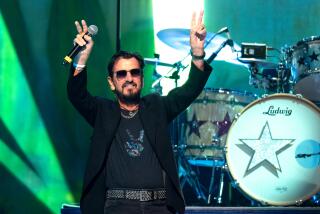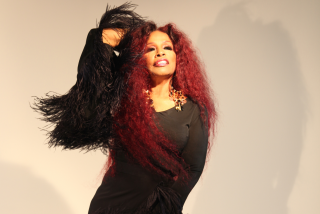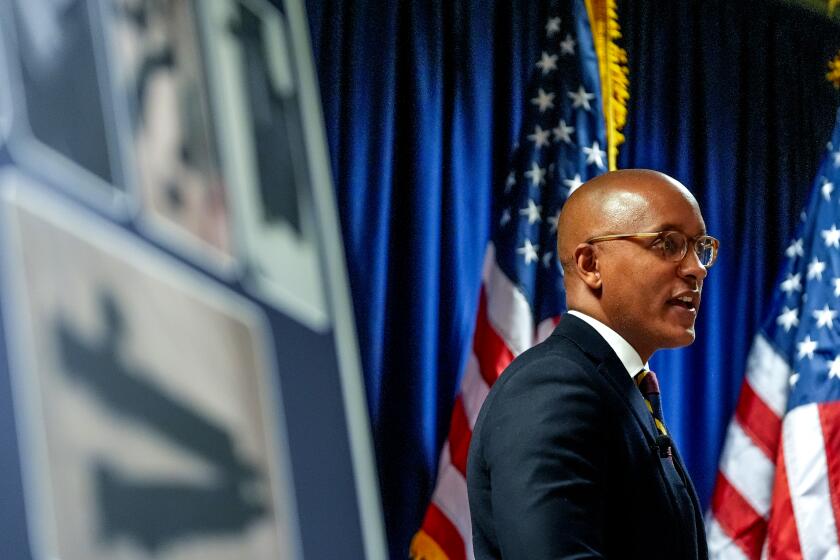A Song for Sinatra
TOLUCA LAKE — Casual fans assume New York is king of the hill, top of the heap, A-No. 1. And Chicago is clearly his kinda town.
But as devoted followers anxiously monitor the health of the 81-year-old Voice, they are celebrating a part of Frank Sinatra’s legacy that has some of its deepest roots in Los Angeles.
The Sinatra Society of America, the largest Sinatra fan club in the U.S., recently changed its address from New York, N.Y., to Toluca Lake, where Sinatra and his first of four wives, Nancy, had a home in the 1940s. In truth, the club’s straight-laced 30-year-old president, Charlie Pignone, moved the Sinatra Society with him when he came to L.A. to take a marketing job.
But he says the transition is fitting, a fresh set of footprints on the same migratory path that brought first the Dodgers and then the Giants to the West. The city, after all, earned the endorsement of the Chairman of the Board himself in his late-career tune, “L.A. Is My Lady.”
Pignone remembers practically learning to walk to the strains of Sinatra in his upstate New York home, thanks to his parents’ deep affection for the music. Rather than dismiss it in favor of the Sex Pistols, though, his heart went ring-a-ding-ding as early as age 8 and he plunged completely into the world of Sinatra. Today, he tends the flame for a club whose 4,000 members are mostly older fans who witnessed their hero’s heyday. The club has few get-togethers, but through letters, e-mail and phone calls, Pignone sees more and more young people starting to catch on to what he has long appreciated. And that gives him hope.
“A hundred years from now, it will probably be considered like classical music,” he said of the Sinatra catalog. “There’s music now, you can go to the Viper Room and these other clubs, but it’s not what I would consider good music. The era [Sinatra and his contemporaries] played in, they were lucky to be there. You could go out every night and see people like Nat Cole.
“When [Sinatra’s] hitting notes and in the pocket . . . it’s a lost art form today. People are screaming these days or they’re rapping. It’s all very unappealing to me.”
Pignone took over the presidency of the club while still attending Siena College in Loudonville, N.Y. By that time, he had already established himself as a super-fan, traveling the country to see shows and indoctrinating fellow students with the message of Ol’ Blue Eyes.
“When I would pop a tape in the car stereo, only a few people would say, ‘Turn that off,’ ” he reported proudly. “A couple of girlfriends didn’t like it, but what are you going to do?”
Pignone long ago won the confidence of former Sinatra band members Bill Miller and Al Viola, whom he met while on the road following Sinatra. He clearly revels in their company and memories, while they see Pignone as a bridge to a new generation of Sinatra fans.
As would be expected, he has an extensive collection of memorabilia, though it doesn’t dominate the clean, white one-bedroom that on many nights serves as Memory Lane for the three New York refugees. Several of Sinatra’s key backup musicians have lived in Greater Los Angeles for decades, including Studio City resident Viola, who, in his mid-70s, plays local clubs.
Viola and other musicians estimate that close to 90% of Sinatra’s recordings were made in L.A., most notably the renowned Capitol and Reprise albums from the 1950s and ‘60s. Like the New Jersey-bred Sinatra and countless other entertainers, Viola and Burbank resident Miller, a pianist who accompanied Sinatra from the early ‘50s through his last tour in ‘94, initially considered Los Angeles little more than a backdrop for their work. Raised in Brooklyn, both mouthed the conventional expatriate lines about sunshine, movies and beaches until they looked up one day and realized they had spent most of their lives here.
Late on a recent weeknight, the pair sat in Pignone’s apartment, chasing a pepperoni pizza with red wine and anisette and pining for a pint of good spumoni. “That’s one thing you can’t find out here,” Miller complained.
Viola kept up a nostalgic patter, with Miller interjecting gravel-voiced observations about “the Old Man,” as both recalled the event that sparked their relationship with Sinatra: the 1956 opening of a club called the Villa Capri.
“At that time L.A. was a happening thing as far as restaurants were concerned and night life was very strong,” Viola said. “People were going out then, which I hope they start doing again someday.”
Soon after that Villa Capri show, the pair began a heavy recording schedule with Sinatra--five LPs a year, recorded at L.A. studios like Capitol or United and always on Monday, Tuesday and Wednesday nights. That period saw the release of such classic Sinatra albums as “In the Wee Small Hours,” “Songs for Swingin’ Lovers” and, arguably his greatest, “Only the Lonely” in 1958.
Sessions would wrap at 11 p.m. and the band would be free to wander the L.A. night, almost always without Sinatra, who kept his after-hours pursuits apart from his colleagues’.
“He was gone. He was out the door,” Viola said. “Many a trombone player said, ‘But Nelson [Riddle, the famed arranger], I played a wrong note!’ And Nelson would say, ‘Well, you’ll have to live with it.’ ”
They frequented a line of bars that snaked from Hollywood to Van Nuys, places called the Hangover Club, Billy Berg’s and the Spotlight. Both night owls still regularly stay out till dawn, but the same can’t be said of their idol.
Though Sinatra’s chief spokesperson, Susan Reynold, says the entertainer is “getting stronger every day,” he rarely ventures from his Beverly Hills home. Late last year, amid a series of hospitalizations, his manager, Eliot Weisman, acknowledged in the Sinatra Society newsletter that Sinatra had finally retired.
“After 60 years on the road, it’s hard to wind down, but he’s adjusting and he’s at peace with himself,” Weisman was quoted as saying.
In recent issues, the quarterly newsletter has chronicled the deaths of entertainment giants Dean Martin, Ella Fitzgerald and George Burns, to name a few. Each passing is acknowledged with a brief eulogy attributed to Sinatra, who more than once shared a stage with the deceased.
“I think it must be hard for him,” said Pignone. “He didn’t go to Dean Martin’s service. Everybody that he hung around with is gone, his contemporaries. Who is left?”
Those close to Sinatra have spent years steeling themselves for the final curtain. But every time news of a health problem leaks out, the phone rings incessantly with calls from dozens of fans whose passion for the music prompts endless cravings for any details of Sinatra’s personal life, especially his health.
“Although the inevitable is going to happen sometime, it’s still going to be a shock,” Pignone said. “But at least we know he’s here. His presence is with us out here. He deserves a chance to take it easy and this is a great place to do that.”
Relaxing around midnight with Viola and Miller, Pignone played a videotape that showed the two on stage with Sinatra and a small combo in Japan during the singer’s famous 1962 world tour.
The neckties were skinny, the music timeless--chestnuts like “I Get a Kick Out of You” and “My Funny Valentine.” Sinatra was at the peak of his powers, moving thousands to swoon at his slightest lilt or sideways smile.
Comparisons to the Sinatra of the 1990s were difficult to fight. Pignone said: “When he first started out, he would come out on stage and just say, ‘Here I am. I’m Frank Sinatra.’ But in the later years, he needed the audience more than the audience needed him. He would end shows completely drained; he’d be crying.” Earlier that evening, Miller recalled one such show, a 1994 date in Japan that proved to be one of Sinatra’s final concerts.
“He forgot practically every lyric,” Miller said in his clipped Bensonhurst accent. “I felt sorry for him. He was deteriorating right under my eyes. Nothing you could do about it. Just go along with it and see what happens. It was sad, actually. That’s when I asked, Why doesn’t he just quit? But we didn’t want him to. . . . We hoped maybe he would snap out of it: ‘C’mon, Frank, get with it.’ And it didn’t happen. We were all rooting for him. Too bad.”
More to Read
The biggest entertainment stories
Get our big stories about Hollywood, film, television, music, arts, culture and more right in your inbox as soon as they publish.
You may occasionally receive promotional content from the Los Angeles Times.










